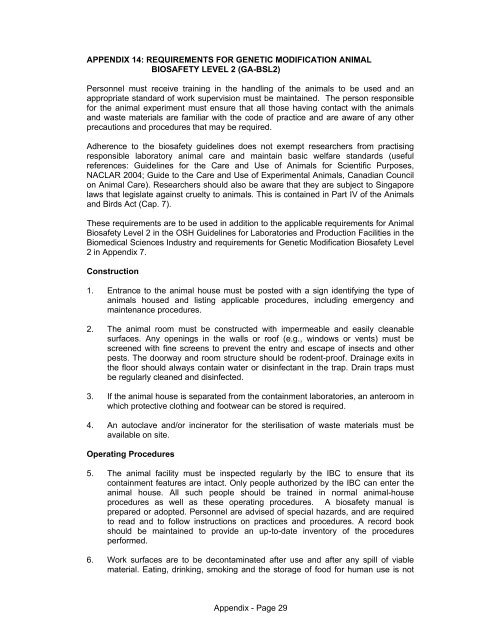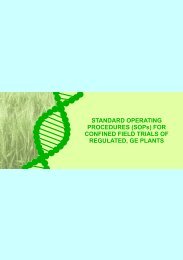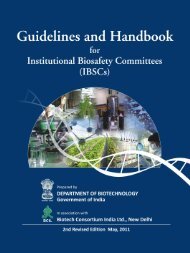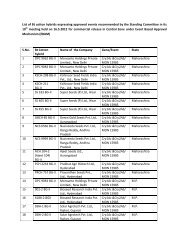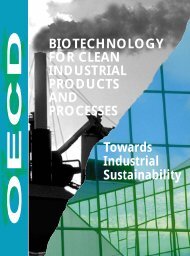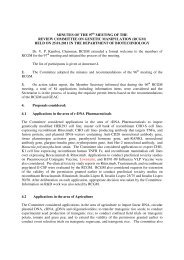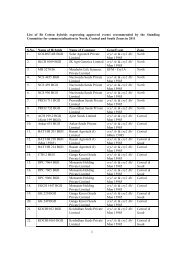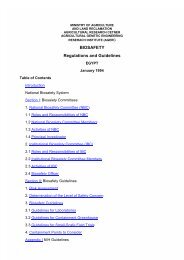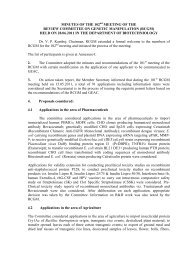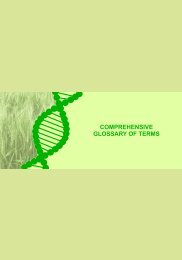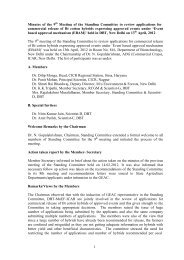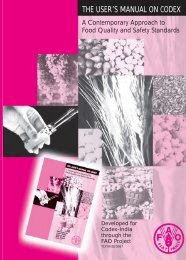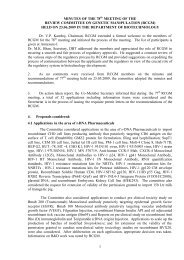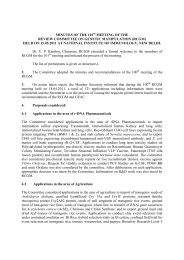Biosafety Guidelines For Research On Genetically Modified ...
Biosafety Guidelines For Research On Genetically Modified ...
Biosafety Guidelines For Research On Genetically Modified ...
Create successful ePaper yourself
Turn your PDF publications into a flip-book with our unique Google optimized e-Paper software.
APPENDIX 14: REQUIREMENTS FOR GENETIC MODIFICATION ANIMAL<br />
BIOSAFETY LEVEL 2 (GA-BSL2)<br />
Personnel must receive training in the handling of the animals to be used and an<br />
appropriate standard of work supervision must be maintained. The person responsible<br />
for the animal experiment must ensure that all those having contact with the animals<br />
and waste materials are familiar with the code of practice and are aware of any other<br />
precautions and procedures that may be required.<br />
Adherence to the biosafety guidelines does not exempt researchers from practising<br />
responsible laboratory animal care and maintain basic welfare standards (useful<br />
references: <strong>Guidelines</strong> for the Care and Use of Animals for Scientific Purposes,<br />
NACLAR 2004; Guide to the Care and Use of Experimental Animals, Canadian Council<br />
on Animal Care). <strong>Research</strong>ers should also be aware that they are subject to Singapore<br />
laws that legislate against cruelty to animals. This is contained in Part IV of the Animals<br />
and Birds Act (Cap. 7).<br />
These requirements are to be used in addition to the applicable requirements for Animal<br />
<strong>Biosafety</strong> Level 2 in the OSH <strong>Guidelines</strong> for Laboratories and Production Facilities in the<br />
Biomedical Sciences Industry and requirements for Genetic Modification <strong>Biosafety</strong> Level<br />
2 in Appendix 7.<br />
Construction<br />
1. Entrance to the animal house must be posted with a sign identifying the type of<br />
animals housed and listing applicable procedures, including emergency and<br />
maintenance procedures.<br />
2. The animal room must be constructed with impermeable and easily cleanable<br />
surfaces. Any openings in the walls or roof (e.g., windows or vents) must be<br />
screened with fine screens to prevent the entry and escape of insects and other<br />
pests. The doorway and room structure should be rodent-proof. Drainage exits in<br />
the floor should always contain water or disinfectant in the trap. Drain traps must<br />
be regularly cleaned and disinfected.<br />
3. If the animal house is separated from the containment laboratories, an anteroom in<br />
which protective clothing and footwear can be stored is required.<br />
4. An autoclave and/or incinerator for the sterilisation of waste materials must be<br />
available on site.<br />
Operating Procedures<br />
5. The animal facility must be inspected regularly by the IBC to ensure that its<br />
containment features are intact. <strong>On</strong>ly people authorized by the IBC can enter the<br />
animal house. All such people should be trained in normal animal-house<br />
procedures as well as these operating procedures. A biosafety manual is<br />
prepared or adopted. Personnel are advised of special hazards, and are required<br />
to read and to follow instructions on practices and procedures. A record book<br />
should be maintained to provide an up-to-date inventory of the procedures<br />
performed.<br />
6. Work surfaces are to be decontaminated after use and after any spill of viable<br />
material. Eating, drinking, smoking and the storage of food for human use is not<br />
Appendix - Page 29


